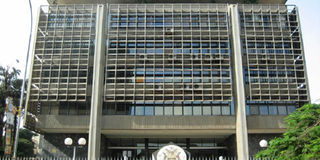Bank of Uganda recovers from Shs859 billion loss

Although the margins were smaller, the Central Bank reported a return to profitability for the year ended June. PHOTO | FILE
Bank of Uganda recovered from a Shs859b loss, posting a profit for the year ended June 2020.
According to details contained in the Bank of Uganda annual report, the Central Bank, for the period running between June 2019 and June 2020, registered a profit of Shs111b mainly because of improved income and reduction in operating expenses.
The Central Bank had for the period ended June 2019 registered a Shs859b loss due to shocks in the foreign exchange market, which wiped out substantial earnings from foreign reserve deposits, and a drastic increase in interest on government paper.
The loss had come on the back of a Shs424.11b profit that the Central Bank had reported for the period ended June 2018.
The annual report, which was released last Thursday, indicates that the Central Bank recorded a 90 per cent increase in interest income while operational expenses reduced minimally by 0.3 per cent.
For instance, the report indicates, during the period to June, the bank reported interest income of Shs423.5b compared to Shs223.4b for the year ended June 2019.
The increase was mainly due to growth in interest income realised on short term and temporary advances to government to fund shortfalls.
Interest income realised from government debt (T-Bills and Bonds) during the period amounted to Shs76.29b while income from temporary advances to fund shortfalls stood at Shs105.9b.
Interest income from foreign reserves, which mainly includes investments in high-yielding markets such as the US, stood at $36m generated from dollar denominated deposits and Treasury Bills compared to $25m realised in the 2018/19 financial year.
The Central Bank, according to the report, also realised income from non-interest components, which stood at Shs255.17b for the period ended June.
However, this was a decline from the Shs271.19b that was realised in the 2018/19 financial year.
The reduction, the Central Bank said, was mainly due to translation and fair value losses recorded by externally managed fund managers during the last quarter of the 2019/20 financial year.
The report also notes that the Central Bank recalled Shs19.18b that it had been provisioned for a write back of Expected Credit Losses resulting from the now defunct Crane Bank.
The Central Bank also reported a minimal reduction in expenses, falling to Shs665.8b compared to Shs686.4b in the 2018/19 financial year.
Expenses on recurrent expenditures, which include currency costs, employee benefits, interest expenses, general and administration costs and financial and professional fees, among others, fell by 3 per cent during the period to June.
Undercapitalised
However, according to the report, Auditor General John S. Muwange, noted that the Central Bank had remained undercapitalised, which could have resulted from increased expenses on monetary and currency costs.
The report indicated that the Central had by June remained undercapitalised to a tune of Shs453.3b, which had been reduced from Shs671.7b in 2019.
The Auditor General noted that expenses on monetary and currency costs could have eroded the Central Bank’s capital in the period to June.
According to the report, Bank of Uganda spent Shs176.8b on monetary costs, which increased from Shs118.37b for the period ended June 2019.
The Central Bank incurs monetary costs through managing financial stability of the economy using deposit auctions and vertical repos.
Currency costs stood at Shs199.3b down from Shs198.2b in the period ended June 2019.
The Central Bank, the report indicates, has already obtained recapitalisations approvals worth Shs481.7b.
Enhancing returns on foreign investments
According to the Bank of Uganda annual report, the Central Bank, during the year to June reviewed and implemented a new strategic asset allocation programme in a bid to effectively match assets and liabilities, as well as enhance returns on foreign investments.
As a result, all holdings managed portfolios denominated in Canada, Australia and Britain currencies were sold and reinvested in US dollar denominations.
As of 30 June 2019, the Central Bank had $1.457b, had invested at relatively higher interest rates that have prevailed in US dollar investments, leading to a growth in the ban’s income.
For instance, the Central Bank realised $25m from US dollar denominated term deposits and Treasury Bills compared to $15m earned in the 2017/18 financial year.
This was informed by the need to enhance returns on external investments boosted by strengthening of the US dollar against major currencies mainly on account of trade tensions between the US and China and the uncertainty sorrounding Brexit.
This resulted in foreign exchange earnings of $19m and an increase of Shs11.799b in ledger fees charged on government transactions.




